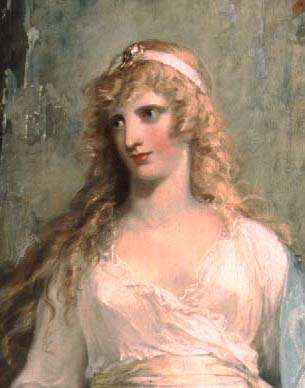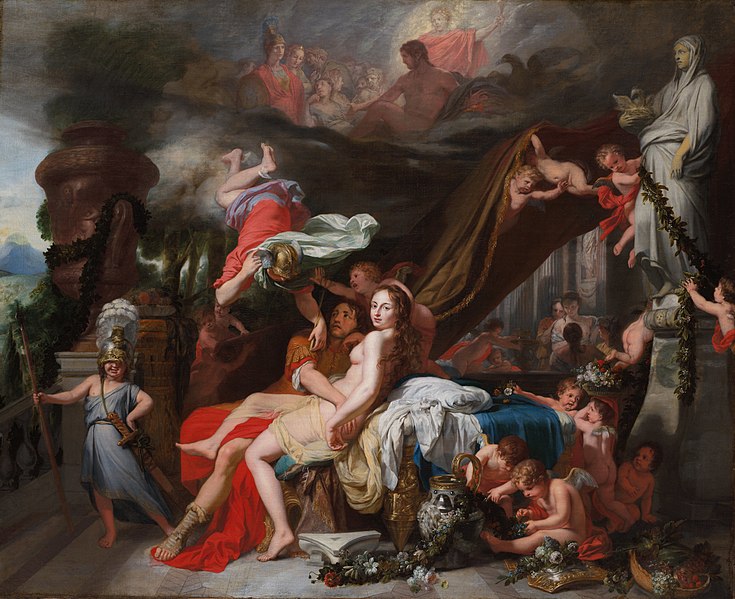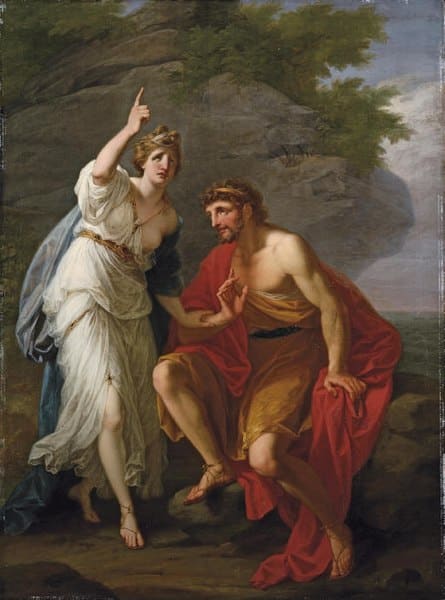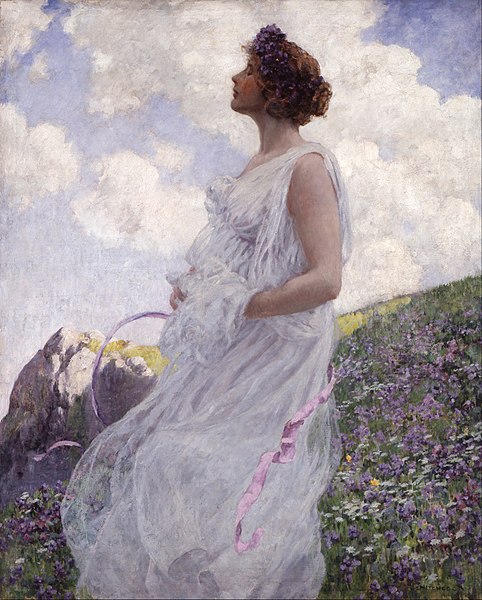In the long list of underrated and misunderstood female characters in Greek mythology, Calypso stands out. Calypso was a nymph, the daughter of Titans Oceanus and Tethys, who lived on the island of Ogygia. She is better known for keeping Odysseus on her island for seven years before being forced to let him go by the other gods, during which she utters one of my favorite phrases in the Odyssey, commenting on the hypocrisy of male gods towards goddesses having affairs with mortals, despite the fact that they have done far worse. Let us find out more about this enchanting nymph’s story.
Calypso Key Facts
| Keyword | Fact |
|---|---|
| Parents | Atlas and Pleione |
| Partners | Odysseus |
| Siblings | The Pleiades, the Hyades, and the Hesperides |
| Offspring | Nausinous |
| Other names | None known |
| Roman name | Same as Greek name |
| The Goddess of | Concealment |
| Symbols | The island of Ogygia |
Name and Etymology
The name Calypso is derived from the Greek word καλύπτω (kalýpto), which translates to “to cover” or “to conceal.” This etymology is reflective of her role in the Odyssey, where she conceals Odysseus from the world and the watchful eyes of the gods, providing him a haven, albeit a forced one, from his destined journey back to Ithaca. The Roman rendition of her name remains unchanged, a testament to her unique position in the mythos of two intertwined civilizations.

Calypso’s name is not just a moniker but a narrative in itself, encapsulating her essence and her actions. Unlike many other figures from Greek mythology, Calypso doesn’t bear a plethora of epithets or alternative names. Her identity is singular and focused, much like her love for Odysseus.
The lack of other known names or epithets for Calypso is intriguing. It sets her apart from other mythological figures who often have multiple names and titles across different regions and narratives. This singularity in nomenclature hints at a straightforwardness or a lack of complexity in her character—at least on the surface.
Calypso Origins
Calypso is believed to be the daughter of the Titan Atlas and the nymph Pleione. Her lineage places her among the divine, yet her story is markedly different from the other gods and goddesses.
Sources are not always in agreement, but most suggest that the Pleiades, the Hyades, and the Hesperides could be considered her siblings, as they are also often cited as daughters of Atlas. The Pleiades are a group of seven sisters, the Hyades are a group of nymphs, and the Hesperides are nymphs associated with a garden bearing golden apples. Each of these groups of siblings has its own set of myths and interactions with other figures in Greek mythology.
Calypso’s role in Greek mythology is that of a nymph, a divine spirit associated with nature. Her abode, the island of Ogygia, is a place of natural beauty and enchantment, reflecting her essence as a nymph. Her story is a blend of the ethereal and the earthly, a narrative that explores the boundaries between the divine and the mortal.
Calypso Lovers and Relationships
Calypso’s tale of love and longing is primarily centered around one significant relationship—that with the hero Odysseus.
Odysseus and Calypso
The narrative of Calypso and Odysseus is one of love, captivity, and eventual parting. Odysseus, on his way home from the Trojan War, finds himself on the shores of Ogygia, where Calypso resides. She takes him in, heals his wounds, and the two become lovers. However, this love soon turns into a form of captivity as Calypso desires to keep Odysseus with her, away from the mortal realm.

Their relationship is a complex blend of affection and control. Calypso offers Odysseus immortality and eternal youth if he stays with her, a tempting offer yet one that comes at the cost of his freedom and his longing to return home. The dichotomy of their relationship reflects the broader theme of struggle between desire and duty that pervades much of Greek mythology.
Nausinous
From her union with Odysseus, Calypso bore a son named Nausinous. However, unlike his father, Nausinous doesn’t play a significant role in the larger narrative of Greek mythology. His existence is a mere footnote in the epic tale of his father’s journey, a reminder of the transient yet impactful union between Calypso and Odysseus.
Depiction And Characteristics
Her beauty is said to be ethereal, with long flowing hair and a grace that captivates all who behold her. The island of Ogygia, her abode, is often seen as an extension of her being—a place of enchantment and allure, much like the nymph herself.
Calypso’s attire is usually depicted as flowing and elegant, often adorned with elements of nature such as flowers and leaves. This not only accentuates her divine beauty but also symbolizes her connection with nature and the island she calls home.
Her initial interactions with Odysseus are tender and caring, showcasing a nurturing aspect of her character. However, as time progresses, her desire to keep Odysseus with her reveals a more possessive side.
Her actions reflect a common theme in Greek mythology—the struggle between love and freedom. Calypso’s character explores the nuances of love, both its nurturing and possessive facets.
Calypso Powers
Being a nymph, Calypso possesses the divine ability to grant immortality and eternal youth. Moreover, this is what she offers to Odysseus in her attempt to keep him by her side. Her powers also extend to the control over her island, making it a haven or a prison as she desires.
Her ability to manipulate the natural surroundings of Ogygia is an example of the close connection between the nymphs and nature in Greek mythology. Calypso’s powers are a direct reflection of her essence as a divine being tied to the natural world.
Calypso Role
Her responsibility, albeit a self-imposed one, is to keep Odysseus with her, away from the perils of his journey and the call of his destiny. However, this responsibility is in direct conflict with the will of the other gods and the fate of Odysseus himself.
Calypso’s tale is a reminder of the inexorable march of fate, a theme that resonates through the annals of Greek mythology. Her story is a poignant exploration of love’s power and its limitations.
Myths about Calypso
The mythological narrative surrounding Calypso is most prominently featured in Homer’s Odyssey. There her encounter with the hero Odysseus unfolds into a tale of love, longing, and eventual parting.
Calypso and Odysseus

The tale begins when Odysseus, journeying home from the Trojan War finds himself shipwrecked on the shores of Ogygia. This is Calypso’s enchanted island. The weary hero is taken in by the compassionate nymph, who nurses him back to health. As time unfolds, their companionship blossoms into a romantic entanglement, with Calypso falling deeply in love with the mortal hero. The island, once a solitary abode for Calypso, instead resonates with melodies of love and the promise of eternal companionship.
Offer Odysseus immortality
Calypso, smitten by Odysseus’s valor and charm, offers him the unthinkable. He can have a chance to escape the clutches of mortality and live forever by her side. She proposes to make him immortal, freeing him from the shackles of aging and death. However, this offer comes with a caveat; Odysseus must relinquish his quest to return to Ithaca. Moreover, he will never again see his beloved wife Penelope or his son Telemachus.
Amidst the serenity of Ogygia and the tender love of Calypso, Odysseus finds himself torn between the immortal love he has found and the mortal love he left behind. His heart yearns for the shores of Ithaca, for the embrace of his wife and the sight of his son. However, the days on Ogygia stretch into years, seven according to the ancient text. With each passing sunset, the heart of Odysseus grows heavier with the longing for his homeland.
During their time together, Calypso and Odysseus conceive a child, a son named Nausinous. The birth of Nausinous is a testament to the profound but transient love shared between Calypso and Odysseus. However, the narrative does not delve much into the life or the fate of Nausinous.
Zeus intervenes
The divine intervention of the gods, led by the decree of Zeus, eventually shatters the tranquility of Calypso’s island. The gods order Calypso to release Odysseus, to allow him to fulfill his destiny of returning home. With a heart heavy with love and sorrow, Calypso complies. She provides Odysseus with the tools and supplies he needs to build a raft. Next she sets him free upon the vast expanse of the sea. Eventually free to pursue the destiny that awaits him.
The parting is bittersweet, filled with the sorrow of unfulfilled love and the harsh reality of divine decree. Calypso’s love for Odysseus remains an immortal tale. It’s a narrative that explores the depths of love, the allure of immortality, and the inexorable pull of destiny. Through the tale of Calypso and Odysseus, the ancient narrative explores the eternal struggle between duty and desire.
Representations Of Calypso In Art
Calypso has been a subject of fascination in art, with numerous depictions of her and Odysseus’s tale. Her ethereal beauty and the dramatic narrative of love and parting have inspired artists through the ages.

The portrayal of Calypso often emphasizes her divine beauty and her connection to the natural world. The scene of her parting with Odysseus is a particularly popular subject. It is capturing both the emotional intensity and the inevitable pull of fate.
Mentions in Ancient Texts
Calypso’s story is primarily told in Homer’s Odyssey, one of the most celebrated works of ancient Greek literature. Written around the 8th century BC, it chronicles Odysseus journey as he strives to return home from the Trojan War.
In the Odyssey, Calypso’s character is explored in depth. It ptovides insight into her personality and her love for Odysseus as well as the struggle between love and duty. The narrative paints a vivid picture of Calypso’s enchanting yet isolated existence on Ogygia.
Frequently Asked Questions
Calypso’s name is derived from the Greek word καλύπτω (kalýpto), which means “to cover” or “to conceal.”
Calypso is believed to be the daughter of the Titan Atlas and the nymph Pleione.
Calypso’s island is called Ogygia, a place of natural beauty and enchantment.
Calypso and Odysseus’s relationship was a complex blend of love and captivity. Calypso fell in love with Odysseus and wanted to keep him with her forever, even offering him immortality. However, Odysseus longed to return home, leading to a bittersweet parting when the gods intervened.
Yes, Calypso had a son named Nausinous with Odysseus.
Featured Image Credit: Gerard de Lairesse, Public domain, via Wikimedia Commons
